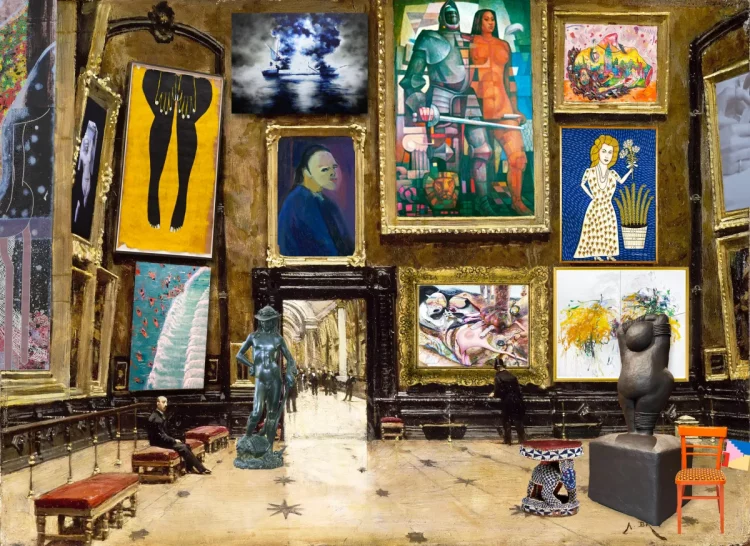I. Introduction: From Museum Halls to Virtual Hubs
In the early decades of the 21st century, the cultural experience of exhibitions underwent a profound transformation. The COVID-19 pandemic accelerated this shift, compelling museums, galleries, and cultural institutions worldwide to explore cloud-based exhibition models.
What began as a stopgap solution for lockdown restrictions has evolved into a permanent and dynamic ecosystem. Today, cloud exhibitions—defined as exhibitions delivered primarily through online platforms, often integrating immersive media—serve not merely as digital replicas of physical displays but as interactive cultural spaces that expand the very definition of what an exhibition can be.
This article explores the historical context, technological foundations, participatory dynamics, and cultural implications of this transformation.
II. Historical Evolution of Exhibition Practices
1. The Physical Exhibition Tradition
For centuries, the exhibition was defined by the physical encounter: artifacts arranged in curated spaces where visitors moved in prescribed paths. The architecture of the Louvre, the British Museum, and the Metropolitan Museum reflected an assumption that culture resided in objects and that meaning emerged through direct, sensory engagement.
2. Early Digital Extensions
With the spread of the internet in the late 1990s, many institutions experimented with online catalogs and virtual tours. These efforts, though pioneering, were largely static—photographs and text on a webpage—providing information rather than a genuine experience.
3. The Pandemic Turning Point
In 2020, global lockdowns shuttered physical spaces, creating an existential crisis for cultural institutions. Platforms such as Google Arts & Culture, museum-developed 3D walkthroughs, and live-streamed exhibition tours became the lifeline for audiences. Importantly, these pandemic-era adaptations revealed that online exhibitions could reach vastly wider audiences, breaking geographical and mobility barriers.
4. Post-Pandemic Hybrid Culture
By the mid-2020s, leading institutions began designing hybrid exhibition strategies, integrating physical and cloud components from the outset. Cloud exhibitions were no longer secondary; they became co-equal channels for curatorial storytelling.
III. Technological Foundations of Cloud Exhibitions
1. High-Resolution Imaging and 3D Scanning
The backbone of cloud exhibitions lies in precise digital capture. Techniques like photogrammetry, LiDAR scanning, and volumetric video allow objects and spaces to be replicated in high fidelity, enabling users to zoom into brushstrokes or inscriptions that might be invisible in a physical gallery.
2. Immersive Environments: VR, AR, and XR
- Virtual Reality (VR) offers fully simulated exhibition spaces, sometimes re-creating historical sites long lost to time.
- Augmented Reality (AR) layers digital objects over physical environments, enabling hybrid experiences even within homes or classrooms.
- Extended Reality (XR) combines VR, AR, and haptic technologies to create a continuum of immersive engagement.
3. Cloud Computing and Scalability
Robust cloud infrastructure ensures that high-resolution content can be delivered smoothly to millions of concurrent users worldwide, supporting features such as multilingual captioning, real-time interaction, and adaptive streaming.
4. AI-Enhanced Curation and Personalization
Machine learning algorithms analyze user behavior—clicks, dwell time, thematic interests—to suggest personalized exhibition routes, recommend related content, and even dynamically reconfigure virtual spaces to suit individual visitor profiles.

IV. The Rise of Interactive Experience
A key distinction between a cloud exhibition and a mere online catalog is interactivity. The transition from passive viewing to active engagement defines the new paradigm.
1. Multi-Layered Storytelling
Digital exhibitions allow curators to embed narrative layers: an ancient manuscript can be accompanied by audio reconstructions of the language, animations of historical context, and clickable scholarly annotations.
2. Social Participation
Many platforms integrate social features—visitor comments, live chats with curators, virtual “tours” led by influencers—that create co-present experiences, echoing the communal dimension of traditional exhibitions.
3. Gamification and Playful Learning
Game mechanics—scavenger hunts, quizzes, achievement badges—have proven effective in encouraging younger audiences to engage more deeply and to return for repeat visits.
4. Accessibility and Inclusion
Cloud exhibitions offer captioned audio, sign-language interpretation, multi-language support, and alternative navigation modes for users with visual or mobility impairments—often surpassing the accessibility of physical spaces.
V. Cultural Impact of Cloud Exhibitions
1. Democratizing Cultural Access
By removing the barriers of geography, mobility, and even ticket pricing, cloud exhibitions have made cultural heritage accessible to audiences in remote regions, classrooms, and homes worldwide.
2. Redefining Authenticity
The digital copy challenges traditional notions of authenticity. Is the aura of the Mona Lisa diminished when viewed in 8K resolution on a tablet? Many scholars argue that digital mediation creates new forms of authenticity rooted in interpretive context and experiential immersion.
3. Archival Preservation
Digital documentation of artifacts and exhibitions creates enduring archives, protecting cultural memory against disasters, conflicts, and climate threats.
4. Commercial Ecosystems
Cloud exhibitions open new revenue streams: premium virtual tours, NFT-based collectibles, branded AR filters, and integrated e-commerce for souvenirs and related publications.
VI. Case Studies of Innovation
- The Louvre’s VR Mona Lisa Experience
A VR exhibit that lets users “step inside” the painting’s Renaissance milieu. - The British Museum’s AR Mummy Unwrapping
Augmented layers reveal scans of a mummy without physically disturbing the artifact. - China’s Dunhuang Grottoes Digital Project
Digitally preserves fragile murals and allows global audiences to explore ancient caves in 3D. - Smithsonian’s Multiplayer Virtual Museum
Visitors can join as avatars, attend live-streamed lectures, and interact with curators in real time.
These cases highlight that interactivity is not a single technology but a creative orchestration of media, storytelling, and audience participation.
VII. Challenges and Critiques
- Digital Divide
Unequal internet access and device availability risk reinforcing existing cultural disparities. - Data Privacy and Security
Personalized experiences rely on user data, raising concerns about surveillance and exploitation. - Over-Commercialization
Excessive focus on monetization can distort curatorial priorities and compromise educational missions. - Attention Economy Fatigue
In a world flooded with online content, maintaining visitor engagement requires constant innovation.
VIII. Future Directions
- Mixed-Reality Cultural Districts
Cities are experimenting with blended physical-digital cultural corridors, where street murals trigger AR experiences or virtual museums complement physical ones. - AI-Curated Dynamic Exhibitions
Future cloud platforms may continuously adapt exhibition layouts based on real-time global audience feedback. - Haptic and Multisensory Interfaces
Advances in touch-feedback devices, scent delivery, and spatial audio promise richer sensory engagement. - Decentralized Cultural Networks
Blockchain-based provenance systems could democratize curatorial authority, enabling artists and small institutions to host verifiable exhibitions on peer-to-peer platforms.
IX. Closing Reflection
Cloud exhibitions and interactive experiences represent not merely a technological trend but a cultural paradigm shift. They expand the concept of the exhibition from a place-based event to a networked, participatory, and adaptive ecosystem.
As institutions, technologists, and audiences continue to co-create this emerging medium, the challenge will be to preserve cultural integrity, promote equity, and cultivate genuine engagement in an era where the boundary between seeing and participating has all but dissolved.

















































